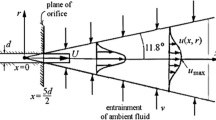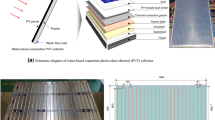Abstract
One of the most common solutions currently available to meet future energy needs in the world is concentrated solar power (CSP) plants combined with thermocline thermal energy storage (TES) tank subsystems. The air rock thermocline TES tank asserts to be an effective and inexpensive TES subsystem for CSP plants. In this study, a discrete element method (DEM) combined with a numerical model of computational fluid dynamics (CFD) was adopted to investigate the thermal performance of a scale model of an air rock thermocline TES tank. The study is carried out to optimize TES thermocline tank's thermal behavior by changing the heat transfer fluid (HTF) inlet velocity. The DEM–CFD coupled model is validated against analytical and experimental data. The results show that the use of the distributor reduced the influence of the wall effect by distributing the HTF in a regular way as the fluid passes through it, especially at high inlet velocity. Moreover, the results show that each TES tank subsystem has a critical velocity at which the tank operates most efficiently. Furthermore, the results demonstrated that the maximum value of the overall cycle efficiency was equal to 70.15% at 10 m/s, while the minimum value was equal to 42.5% at 2 m/s. The highest capacity and utilization ratio are 81.31 and 72.81% at 16 m/s, while the lowest capacity and utilization ratio are 52.01 and 44.75% at 2 m/s. The pumping energy needed to overwhelm the pressure drop rises when the HTF inlet velocity increases. This study can provide an effective reference for the efficient operation regulation and optimal design of the thermocline tank.
Graphic abstract















Similar content being viewed by others
References
Agalit H, Zari N, Maaroufi M (2020) Suitability of industrial wastes for application as high temperature thermal energy storage (TES) materials in solar tower power plants-a comprehensive review. Sol Energy 208:1151–1165
Alptekin E, Ezan MA (2020) Performance investigations on a sensible heat thermal energy storage tank with a solar collector under variable climatic conditions. Appl Therm Eng. https://doi.org/10.1016/j.applthermaleng.2019.114423
Auwerda G, Kloosterman J, Winkelman A, Groen J, Van Dijk V (2010) Comparison of experiments and calculations of void fraction distributions in randomly stacked pebble beds PHYSOR 2010. Adv React Phys Power Nucl Renaiss: 1897–1909
Awan AB, Zubair M, Chandra Mouli KVV (2020) Design, optimization and performance comparison of solar tower and photovoltaic power plants. Energy. https://doi.org/10.1016/j.energy.2020.117450
Bai Y, Yang M, Wang Z, Li X, Chen L (2019) Thermal stratification in a cylindrical tank due to heat losses while in standby mode. Sol Energy 185:222–234. https://doi.org/10.1016/j.solener.2018.12.063
Bergman TL, Incropera FP, DeWitt DP, Lavine AS (2011) Fundamentals of heat and mass transfer. Wiley
Bu SS, Yang J, Zhou M, Li SY, Wang QW, Guo ZX (2014) On contact point modifications for forced convective heat transfer analysis in a structured packed bed of spheres. Nucl Eng Des 270:21–33. https://doi.org/10.1016/j.nucengdes.2014.01.001
Caccia M et al (2018) Ceramic–metal composites for heat exchangers in concentrated solar power plants. Nat 562:406–409
Cascetta M, Cau G, Puddu P, Serra F (2016) A comparison between CFD simulation and experimental investigation of a packed-bed thermal energy storage system. Appl Therm Eng 98:1263–1272. https://doi.org/10.1016/j.applthermaleng.2016.01.019
Cocco D, Serra F (2015) Performance comparison of two-tank direct and thermocline thermal energy storage systems for 1 MWe class concentrating solar power plants. Energy 81:526–536
Díaz-Heras M, Belmonte JF, Almendros-Ibáñez JA (2020) Effective thermal conductivities in packed beds: Review of correlations and its influence on system performance. Appl Therm Eng 171:115048. https://doi.org/10.1016/j.applthermaleng.2020.115048
Dixon AG (1988) Correlations for wall and particle shape effects on fixed bed bulk voidage The. Can J Chem Eng 66:705–708. https://doi.org/10.1002/cjce.5450660501
Dixon AG, Walls G, Stanness H, Nijemeisland M, Stitt EH (2012) Experimental validation of high Reynolds number CFD simulations of heat transfer in a pilot-scale fixed bed tube. Chem Eng J 200–202:344–356. https://doi.org/10.1016/j.cej.2012.06.065
Eisfeld B, Schnitzlein K (2001) The influence of confining walls on the pressure drop in packed beds. Chem Eng Sci 56:4321–4329. https://doi.org/10.1016/S0009-2509(00)00533-9
Ergun S (1952) Fluid flow through packed columns. Chem Eng Prog 48:89–94
Filali Baba Y, Ajdad H, Mers AAL, Grosu Y, Faik A (2019) Multilevel comparison between magnetite and quartzite as thermocline energy storage materials. Appl Therm Eng 149:1142–1153. https://doi.org/10.1016/j.applthermaleng.2018.12.002
Gautam A, Saini RP (2020) A review on technical, applications and economic aspect of packed bed solar thermal energy storage system. J Energy Storage. https://doi.org/10.1016/j.est.2019.101046
Gosens J, Binz C, Lema R (2020) China’s role in the next phase of the energy transition: contributions to global niche formation in the concentrated solar power sector. Environ Innov Soc Trans 34:61–75
Guo Z, Sun Z, Zhang N, Ding M (2019) Influence of confining wall on pressure drop and particle-to-fluid heat transfer in packed beds with small D/d ratios under high Reynolds number. Chem Eng Sci 209:115200. https://doi.org/10.1016/j.ces.2019.115200
Hänchen M, Brückner S, Steinfeld A (2011) High-temperature thermal storage using a packed bed of rocks-heat transfer analysis and experimental validation. Appl Therm Eng. https://doi.org/10.1016/j.applthermaleng.2010.10.034
Hand M (2012) Renewable electricity futures study (Golden, CO: National Renewable Energy Laboratory). NREL/TP-6A20–52409. httpuf/www. nre1. gov/analy-sis/re_futures
Hoffmann JF, Fasquelle T, Goetz V, Py X (2017) Experimental and numerical investigation of a thermocline thermal energy storage tank. Appl Therm Eng 114:896–904. https://doi.org/10.1016/j.applthermaleng.2016.12.053
Hu C, Sun M, Xie Z, Yang L, Song Y, Tang D, Zhao J (2020) Numerical simulation on the forced convection heat transfer of porous medium for turbine engine heat exchanger applications. Appl Therm Eng. https://doi.org/10.1016/j.applthermaleng.2020.115845
Jemmal Y, Zari N, Asbik M, Maaroufi M (2020) Experimental characterization and thermal performance comparison of six Moroccan rocks used as filler materials in a packed bed storage system. J Energy Storage 30:101513. https://doi.org/10.1016/j.est.2020.101513
Keyif E, Hornung M, Zhu W (2020) Optimal configurations and operations of concentrating solar power plants under new market trends. Appl Energy 270:115080. https://doi.org/10.1016/j.apenergy.2020.115080
Li B, Ju F (2018) Thermal stability of granite for high temperature thermal energy storage in concentrating solar power plants. Appl Therm Eng 138:409–416. https://doi.org/10.1016/j.applthermaleng.2018.04.071
Mohan G, Venkataraman MB, Coventry J (2019) Sensible energy storage options for concentrating solar power plants operating above 600 °C. Renew Sustain Energy Rev. https://doi.org/10.1016/j.rser.2019.01.062
Mueller GE (1992) Radial void fraction distributions in randomly packed fixed beds of uniformly sized spheres in cylindrical containers. Powder Technol 72:269–275. https://doi.org/10.1016/0032-5910(92)80045-X
Nada SA, Elfeky KE, Attia AMA (2016) Experimental investigations of air conditioning solutions in high power density data centers using a scaled physical model. Int J Refrig 63:87–99. https://doi.org/10.1016/j.ijrefrig.2015.10.027
Nijemeisland M, Dixon AG (2001) Comparison of CFD simulations to experiment for convective heat transfer in a gas–solid fixed bed. Chem Eng J. https://doi.org/10.1016/S1385-8947(00)00360-0
Nyembwe AM, Cromarty RD, Garbers-Craig AM (2019) Simulation of the pressure drop across granulated mixtures using a coupled DEM–CFD model. Adv Powder Technol. https://doi.org/10.1016/j.apt.2018.10.010
Palacios A, Barreneche C, Navarro ME, Ding Y (2020) Thermal energy storage technologies for concentrated solar power-a review from a materials perspective. Renew Energy. https://doi.org/10.1016/j.renene.2019.10.127
Picotti G et al (2020) Optimization of cleaning strategies for heliostat fields in solar tower plants. Sol Energy 204:501–514. https://doi.org/10.1016/j.solener.2020.04.032
Reddy KS, Jawahar V, Sivakumar S, Mallick TK (2017) Performance investigation of single-tank thermocline storage systems for CSP plants. Sol Energy 144:740–749. https://doi.org/10.1016/j.solener.2017.02.012
Rodrigues FA, de Lemos MJS (2020) Effect of porous material properties on thermal efficiencies of a thermocline storage tank. Appl Therm Eng 173:115194. https://doi.org/10.1016/j.applthermaleng.2020.115194
Sahimi M (2011) Flow and transport in porous media and fractured rock: from classical methods to modern approaches. Wiley
Schellekens G, Battaglini A, Lilliestam J, McDonnell J, Patt A (2010) 100% renewable electricity: a roadmap to 2050 for Europe and North Africa
Sharma A, Thakur A, Saha SK, Sharma A, Sharma D, Chaudhuri P (2020) Thermal-hydraulic characteristics of purge gas in a rectangular packed pebble bed of a fusion reactor using DEM-CFD and porous medium analyses. Fusion Eng Des 160:111848. https://doi.org/10.1016/j.fusengdes.2020.111848
Tiskatine R, Oaddi R, Ait El, Cadi R, Bazgaou A, Bouirden L, Aharoune A, Ihlal A (2017) Suitability and characteristics of rocks for sensible heat storage in CSP plants. Solar Energy Mater Solar Cells 169:245–257. https://doi.org/10.1016/j.solmat.2017.05.033
van der Merwe WJS, du Toit CG, Kruger JH (2020) Influence of the packing structure on the flow through packed beds with small cylinder diameter to particle diameter ratios. Nucl Eng Des 365:110700. https://doi.org/10.1016/j.nucengdes.2020.110700
Wang P, Chen L-Y, Ge J-P, Cai W, Chen W-Q (2019) Incorporating critical material cycles into metal-energy nexus of China’s 2050 renewable transition. Appl Energy 253:113612
Xiang J, Munjiza A, Latham J-P, Guises R (2009) On the validation of DEM and FEM/DEM models in 2D and 3D. Eng Comput 26:673–687
Yang X, Cai Z (2019) An analysis of a packed bed thermal energy storage system using sensible heat and phase change materials. Int J Heat Mass Transf 144:118651. https://doi.org/10.1016/j.ijheatmasstransfer.2019.118651
Zanganeh G, Khanna R, Walser C, Pedretti A, Haselbacher A, Steinfeld A (2015) Experimental and numerical investigation of combined sensible latent heat for thermal energy storage at 575 °C and above. Sol Energy. https://doi.org/10.1016/j.solener.2015.01.022
Zaversky F, PérezdeZabalzaAsiain J, Sánchez M (2017) Transient response simulation of a passive sensible heat storage system and the comparison to a conventional active indirect two-tank unit. Energy 139:782–797. https://doi.org/10.1016/j.energy.2017.07.156
Acknowledgements
This work is financially supported by the National Natural Science Foundation of China (Grant No. 51536007), the National Natural Science Foundation of China (NSFC)/Research Grants Council (RGC) Joint Research Scheme (Grant No. 51861165105), and the Foundation for Innovative Research Groups of the National Natural Science Foundation of China (No.51721004), and the 111 Project (B16038).
Author information
Authors and Affiliations
Corresponding author
Ethics declarations
Conflict of interest
The authors declare that they have no conflict of interest.
Additional information
Publisher's Note
Springer Nature remains neutral with regard to jurisdictional claims in published maps and institutional affiliations.
Rights and permissions
About this article
Cite this article
Elfeky, K.E., Mohammed, A.G. & Wang, Q.w. Performance analysis of an air rock thermocline TES tank for concentrated solar power plants using the coupled DEM–CFD approach. Clean Techn Environ Policy 24, 3–19 (2022). https://doi.org/10.1007/s10098-021-02030-1
Received:
Accepted:
Published:
Issue Date:
DOI: https://doi.org/10.1007/s10098-021-02030-1




